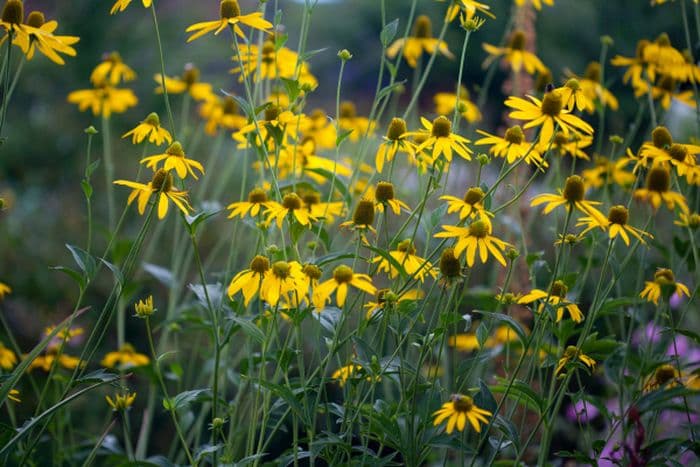Cutleaf Coneflower Rudbeckia laciniata

ABOUT
The Cutleaf coneflower is a perennial plant known for its distinctive foliage and bright floral displays. The leaves of this plant are deeply lobed and can vary in shape, but often they are pinnately divided with jagged edges, giving them a somewhat 'cut' appearance that inspires its common name. These green leaves create a lush backdrop for the flowers. The flowers are particularly eye-catching, with golden-yellow petals that radiate from a central greenish-brown to dark chocolate-colored cone. Each flower features numerous long, slender, and daisy-like petals that can droop slightly around the edges of the cone. The blossoms form clusters at the tops of the stems, presenting themselves prominently for pollinators. Overall, it's the bright, sunny flowers with their prominent central cone that are the most striking part of the Cutleaf coneflower, creating a cheerful display that's often seen in gardens and naturalized areas. The entire plant gives off a wildflower-like charm and can be quite robust and bushy in its foliage.
About this plant
 Names
NamesFamily
Asteraceae.
Synonyms
Cutleaf Coneflower, Green-headed Coneflower, Cutleaf, Goldenglow, Tall Coneflower, Sochan, Thimbleweed.
Common names
Rudbeckia digitata Mill., Rudbeckia laciniata var. ampla Fernald, Rudbeckia laciniata var. bipinnata Farw., Rudbeckia laciniata var. digitata (Mill.) Pursh, Rudbeckia laciniata var. heterophylla Torr. & A.Gray, Rudbeckia laciniata var. humilis Alexander, Rudbeckia laciniata var. laciniata, Rudbeckia laciniflora Raf., Rudbeckia lancifolia Greene, Rudbeckia lanciniata Hill, Rudbeckia lanciniata var. lanciniata, Rudbeckia pinnata Lehm., Rudbeckia procera Lehm.
 Toxicity
ToxicityTo humans
The plant commonly known as cutleaf coneflower, or Rudbeckia laciniata, is not generally considered toxic to humans. There are no commonly reported cases of poisoning or significant adverse effects from ingesting this plant. However, sensitivity to plants can vary among individuals, and it is usually advisable not to consume plant parts unless they are known to be edible.
To pets
Cutleaf coneflower, or Rudbeckia laciniata, is not known to be toxic to pets either. It is not typically associated with poisoning in domestic animals like dogs and cats. As with humans, individual sensitivities can vary, but there are no widespread reports of toxic reactions in pets from ingesting this plant. It is still a good practice to monitor your pets and prevent them from eating large quantities of any non-food plants, as they can sometimes cause gastrointestinal upset or other non-toxic reactions.
 Characteristics
CharacteristicsLife cycle
Perennials
Foliage type
Deciduous
Color of leaves
Green
Flower color
Yellow
Height
3-9 feet (0.9-2.7 meters)
Spread
1-3 feet (0.3-0.9 meters)
Plant type
Herb
Hardiness zones
3-9
Native area
North America
Benefits
 General Benefits
General Benefits- Attracts Pollinators: Rudbeckia laciniata, commonly known as cutleaf coneflower, draws bees, butterflies, and other beneficial insects to the garden, aiding in pollination.
- Aesthetic Appeal: With its bright yellow flowers and tall stature, cutleaf coneflower adds visual interest and beauty to landscapes and gardens.
- Wildlife Habitat: The plant provides food in the form of nectar and seeds for various animals, including birds and insects.
- Erosion Control: The extensive root system of cutleaf coneflower can help to stabilize soil and reduce erosion on banks and slopes.
- Drought Resistance: Once established, this plant is relatively drought-tolerant, requiring minimal watering in suitable climates.
- Easy to Grow: Cutleaf coneflower is known for being easy to cultivate, requiring little maintenance and being adaptable to a range of soil conditions.
- Naturalizing: It can spread and naturalize in an area, filling out spaces and providing a more natural, wildflower-like appearance.
- Seasonal Interest: The plant blooms from late summer to fall, providing color and interest to gardens at a time when many other plants are declining.
 Medical Properties
Medical Properties- Anti-inflammatory: Rudbeckia laciniata has been used traditionally to help reduce inflammation.
- Wound healing: It is thought to promote healing of minor wounds and skin irritations.
- Antiseptic: The plant may have mild antiseptic properties, useful for treating insect bites or stings.
- Immune system support: Some herbalists use it to strengthen the immune system.
 Air-purifying Qualities
Air-purifying QualitiesThis plant is not specifically known for air purifying qualities.
 Other Uses
Other Uses- Rudbeckia laciniata, commonly known as cutleaf coneflower, can be used as a natural dye, providing yellow color when the flowers are used in a dye bath.
- The plant's tall stature and large leaves make it an excellent backdrop for ornamental grasses and other perennials in landscape design.
- Cutleaf coneflowers are also utilized in large wildflower gardens to attract butterflies and other pollinators, which are essential for a healthy ecosystem.
- The seeds of Rudbeckia laciniata are a source of food for birds, especially finches, during the fall and winter months.
- The cutleaf coneflower can be used in large floral arrangements, where its bold yellow flowers provide a striking visual element.
- In educational settings, Rudbeckia laciniata serves as a subject for studying plant biology and pollination due to its accessibility and interesting features.
- The extensive root system of the cutleaf coneflower helps with soil stabilization and can prevent erosion on banks and slopes.
- Rudbeckia laciniata's resilient nature allows it to be used in remediation projects for disturbed sites, helping to restore native plant populations.
- These plants can function as a privacy screen when planted in dense rows because of their height and bushy growth habit.
- The dried seed heads of cutleaf coneflower add texture and interest to winter gardens or as part of dried flower arrangements.
Interesting Facts
 Feng Shui
Feng ShuiThe Cutleaf Coneflower is not used in Feng Shui practice.
 Zodiac Sign Compitability
Zodiac Sign CompitabilityThe Cutleaf Coneflower is not used in astrology practice.
 Plant Symbolism
Plant Symbolism- Hope: Rudbeckia laciniata, commonly known as the Cutleaf Coneflower, is often associated with hope due to its bright yellow flowers that resemble the sun, symbolizing new beginnings and the belief that something better is on the horizon.
- Justice: The straight, tall stance of this plant can be symbolic of justice, representing uprightness and fairness.
- Longevity: As a perennial, the Cutleaf Coneflower comes back year after year, symbolizing endurance and the passage of time.
- Good Fortune: The full, lush blooms are sometimes seen as a symbol of prosperity and good luck, making them a positive omen in gardens.
- Optimism: With its vibrant, cheerful flowers that follow the sun across the sky, Cutleaf Coneflower can symbolize an optimistic outlook and a cheerful disposition.
 Water
WaterCutleaf coneflower, commonly known as Rudbeckia laciniata, should typically be watered once a week with about 1 to 1.5 inches of water to mimic natural rainfall. The soil should be kept evenly moist, but not soggy, so adjust the amount of water according to your climate conditions, including heat and humidity. During periods of drought or extreme heat, additional water may be necessary. It's best to water in the early morning or late afternoon to reduce evaporation and ensure that water reaches the roots. For mature plants, a deep and thorough watering is preferable to frequent shallow waterings, as it encourages a stronger root system.
 Light
LightCutleaf coneflower thrives in full sun to partial shade. The ideal location for this plant offers about 6 to 8 hours of direct sunlight per day. However, it can tolerate partial shade, especially in hotter climates where some relief from the intense afternoon sunlight can be beneficial to the plant.
 Temperature
TemperatureThe cutleaf coneflower is a resilient plant that can withstand a wide range of temperatures, growing well in USDA hardiness zones 3 through 9. It can survive low temperatures down to -40 degrees Fahrenheit and high temperatures typical of most temperate climates. The ideal growing temperature for maximum blooming is between 60 and 70 degrees Fahrenheit.
 Pruning
PruningPruning cutleaf coneflower is essential to promote continuous blooming and to maintain the plant's shape. Deadheading, or removing spent flowers, encourages new growth and prevents the plant from self-seeding too aggressively. In late winter or early spring, prune back the old foliage to make way for fresh growth. The best time to prune for shaping is just after flowering to give the plant time to harden off before winter sets in.
 Cleaning
CleaningAs needed
 Soil
SoilCutleaf coneflower thrives in a well-draining, fertile soil with a pH between 6.1 and 7.8. A good mix for this plant would be loam or sandy loam enriched with compost or well-rotted manure. To enhance drainage and provide necessary nutrients, incorporate a balanced mix of peat, perlite, and organic compost into the native soil.
 Repotting
RepottingCutleaf coneflower does not typically require frequent repotting. It should be repotted every 2-3 years or when the plant becomes root-bound. Ensure you use a fresh soil mix that aligns with its natural habitat when repotting.
 Humidity & Misting
Humidity & MistingCutleaf coneflower prefers moderate humidity conditions but is relatively tolerant of variations in humidity. It typically does well in the average outdoor humidity levels found in its growing zones.
 Suitable locations
Suitable locationsIndoor
Ensure bright light, moderate moisture, and spacious pot.
Outdoor
Provide full sun, good drainage, and space for growth.
Hardiness zone
3-9 USDA
 Life cycle
Life cycleThe common name for Rudbeckia laciniata is the cutleaf coneflower. Its life cycle begins with seed germination, which typically occurs in late winter or early spring. As the seedlings grow, they develop into rosettes of deeply divided leaves. Throughout the spring and into summer, the plant develops a tall, branched stem and produces large, daisy-like yellow flowers with a prominent central cone, typically blooming from late summer into fall. After pollination, seeds are formed and dispersed, and the plant then enters a dormancy period during the winter months. With the return of favorable conditions in the spring, Rudbeckia laciniata resumes growth from the roots, as it is a perennial, and the cycle repeats.
 Propogation
PropogationPropogation time
Late Spring-Early Summer
Propogation: The coneflower, known scientifically as Rudbeckia laciniata, can be easily propagated through division, which is its most popular method. This process should be carried out in the springtime, just as the new growth begins to emerge. To propagate by division, carefully dig up an established clump, ensuring a generous amount of soil surrounds the rootball. The clump should then be gently split into smaller sections, each with a good amount of roots and at least one or two shoots. These individual divisions can then be immediately replanted in a prepared garden location or potted up if necessary. They should be spaced about 18 to 30 inches (45 to 76 centimeters) apart to accommodate their mature size. Water the new divisions thoroughly after planting to help establish them in their new locations.









